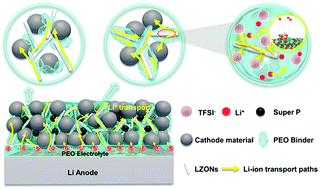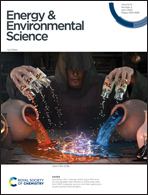Constructing a highly efficient “solid–polymer–solid” elastic ion transport network in cathodes activates the room temperature performance of all-solid-state lithium batteries†
Abstract
All-solid-state lithium batteries (ASSLBs) face the critical challenge of an extremely poor room temperature (RT) performance. The widely known restricting factors are the low ionic conductivity of solid-state electrolytes and high resistance of the electrolyte–electrode interfaces. Herein, we identify that the Li-ion transport efficiency in the cathode is notably underestimated or ignored, which is actually a more critical factor restricting the ASSLB performance. By constructing highly efficient “solid–polymer–solid” elastic Li-ion transport channels using La2Zr2O7 nanofibers (LZONs) and poly(ethylene oxide) (PEO) with active materials in the cathode, LiFePO4/Li ASSLBs can stably cycle 1500 times at RT, even when using a polyethylene oxide electrolyte with a low ionic conductivity of 4.56 × 10−6 S cm−1. Furthermore, the sold-state LiNi0.8Co0.1Mn0.1O2/poly(vinylidene fluoride)-based SPEs/Li battery with LZONs and a PEO ion transport network can be stably cycled 2880 times. LZONs with abundant oxygen vacancies not only provide highly efficient Li-ion transport paths, but also immobilize the anions to promote Li salt dissociation and generate sufficient free Li-ions in the PEO binder, which significantly improves the Li-ion transport efficiency and achieves a high ASSLB performance at RT with different cathodes and electrolytes. This work reveals that the construction of a highly efficient ion transport network inside the cathode can completely activate the RT performance of ASSLBs. This work provides guidance on a robust methodology for developing advanced ASSLBs.



 Please wait while we load your content...
Please wait while we load your content...